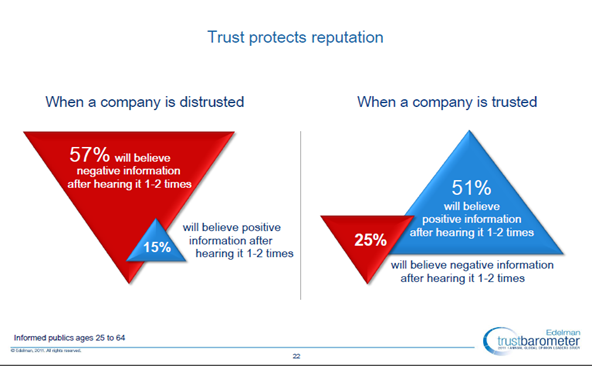Topic 4.2: Definitions of Trust
Numerous definitions or descriptions of trust have been offered, as the following selections from a comprehensive summary by Watson (2004) demonstrates.
As you read through these selected descriptions and definitions, note the contexts from which they are offered and identify those that most strongly resonate with you.
Psychology & Sociology |
|
| Rotter (1967 & 1980:651) | “A generalized expectancy held by an individual that the word, promise, oral or written statement of another individual or group can be relied upon” |
| Griffin (1967: 05) | “The reliance upon the behavior of a person in order to achieve a desired but uncertain objective in a risky situation” |
| Gambetta (1988:217) | “The probability that a person with whom we are in contact will perform an action that is beneficial or at least not detrimental is high enough for us to consider engaging in some form of cooperation with him” |
| Carnevale & Weschler (1992: 473) | “The expectation of ethical, fair, and non-threatening behavior, and concerns for the rights of others” |
| Sabel (1993:1133) | “The mutual confidence that no party to an exchange will exploit the other’s vulnerability” |
| McAllister (1995:25) | “The extent to which a person is confident in, and willing to act on the basis of, the words, actions, and decisions of another” |
Marketing |
|
| Morgan & Hunt (1994: 23) | “When one party has confidence in an exchange partner’s reliability and integrity” |
| Delgado-Ballester, Munuera Aleman, & Yague-Guillen (2003:31) | “Feeling of security held by the consumer in his/her interaction with the brand, that it is based on the perceptions that the brand is reliable and responsible for the interests and welfare of the consumer” |
Organisational Behaviour |
|
| Blomqvist & Stahle (2000: 4) | “An actor’s expectation of the other party’s competence, goodwill and behavior” |
| Zaheer, McEvily, & Perrone (1998: 143) | “The expectation that an actor (1) can be relied on to fulfil obligations, (2) will behave in a predictable manner, and (3) will act and negotiate fairly when the possibility for opportunism is present” |
| Sitkin & Roth (1993: 373) | “A belief in a person’s competence to perform a specific task under specific circumstances” |
Public Relations |
|
| Broom, Casey & Ritchey (1997:98) | “Predictability that one party will behave in a specific and desired way” |
| Heath, Seshadri & Lee (1998:40) | “Perceived competence, objectivity, fairness, consistency, goodwill, confidence, and the prediction that others will act supportively rather than exploitatively” |
| (Grunig & Hon 1999:3) | “One party’s level of confidence in and willingness to open oneself to the other party” |
Some of these definitions have been applied in multiple disciplines; the table is created based on the initial application of the definition. Source: Watson, M.L. (2004).[1]
Regardless of how we describe trust, it remains essential to the effectiveness and sustainability of our professional and personal relationships. Stephen M.R. Covey has written a best-selling business book on trust (The Speed of Trust) in which he says: “the ability to establish, grow, extend, and restore trust with all stakeholders – customers, suppliers, investors and co-workers – is the key leadership competency of the new, global economy” (2006, p21)[2].
This is borne out by the Edelman Trust Barometer which, in part, highlights how trustworthiness is key to reputation and credibility. “We have studies trust from more than 20 years and believe that it is the ultimate currency in the relationship that all institutions – companies and brands, governments, NGOs and media – build with their stakeholders. Trust defines an organization’s license to operate, lead and succeed. Trust is the foundation that allows an organization to take responsible risk, and, if it makes mistakes, to rebound from them.”[3]
They also identify some of the key issues that drive trust in organisational life. In public sector and not-for-profit organisations there are some particular issues in terms of trust and reputation – particularly given the strong focus on public good and community benefit that lies at the heart of most public sector organisations. If we trust and organisation and its people we are much more likely to believe key messages and communication from that organisation or group.
 +
+
Recommended Reflection
20 mins
- Do you know what your key stakeholders expect of your organisation in order to determine whether or not it is trustworthy? What are they looking for?
- What sorts of things might compromise, erode or destroy trust?
- What intentional strategies are you aware of and / or do you practise to build trust and maintain trust with key stakeholders – including the communities who benefit from your work.
Deeper Learning Refleciton
10 mins
- Now that you have read through this list of descriptions, which appeal most strongly to you? Why?
- What themes or consistent language or ideas emerge?
- Can you offer your own working definition of trust? (You may want to adapt one of the descriptions in the list.)
- Watson, M.L. (2004). Can there be just one trust? A cross-disciplinary identification of trust definitions and measurement. Submission to the Institute for Public Relationship 2004 Ketchum Excellence in Public Relations Research Award. ↵
- Covey, S.M.R. (2006). The Speed of Trust. New York: Free Press ↵
- Edelman. (n.d.). Why we study trust. Edelman. https://www.edelman.com/trust ↵

